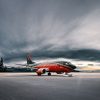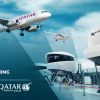
Though there are certain signs that the post-crisis global economy is on a steady path towards recovering its stability, the latest results of the U.S. economy (minus 2.9% in Q1 2014, the largest drop since the 2009) serves as a serious warning that the actual growth of the global market is fragile. In the meantime, burdened by traditional assets, today many investors are seeking for alternative investments which would diversify their portfolios and allocate the risks. However, in their quest for new liquid projects, investors seem to ignore an asset which many of them personally use on a daily basis – an aircraft.
The “hardest” asset of all
Unlike real estate or other infrastructure, an aircraft – as an asset – generates more stable and predictable cash flows based on monthly lease payments. Moreover, with proper technical maintenance modern aircraft may sustain their economic efficiency for as many as 25 years. Afterwards, at the end of its economic life, an aircraft may be torn down to separate parts and components which can be then sold on the aftermarket.
In addition, aircraft transactions are normally funded in US dollars thus reducing various financial risks, including currency, interest rates and re-financing related ones.
“Many consider asset diversification to be an optional solution, until it is too late. Today predicting the accuracy of risk associated with some “traditional” assets resembles the process of forecasting weather. This is so due to the fact that the financial markets are still fragile and one cannot be certain of how they will develop in a year or two. That’s why some investors prefer to minimize their high-risk assets in advance in order to insure themselves against potential hidden risks,” comments Tadas Goberis, the CEO of AviaAM Leasing. “In the meantime, an investment in aircraft not only brings you a truly globally-demanded “hard” asset, but also gives you an opportunity to enjoy an annual 10-15% ROI.”
The story of success
Recently, AviaAM Leasing has concluded a 300 million USD worth project, under which the company has created and managed an aircraft portfolio consisting of five Boeing 737-800, one Boeing 737-700, one Boeing 767-300, two Airbus A321-200 and two Bombardier CRJ200 airplanes. The portfolio was formed on behalf of one of the leading Russian financial market players. All 11 aircraft were located and delivered to the investor in just 8 months, being subsequently re-furbished and leased to various CIS-based operators under 5-8 years long leases. The investor is already enjoying up to 20% return per year (depending on an aircraft type).
“Europe, the Americas, Asia – pick any region you like – it actually doesn’t matter where your aircraft is flying. As an asset it is secured by international treaties, including the Cape Town Treaty. Under the treaty, the owner’s rights are guaranteed by the state where the lessee is registered. Moreover, the lessor holds priority rights on the asset in case of the lessee‘s default,” explains Tomas Sidlauskas, Senior Project Manager at AviaAM Leasing. “Meanwhile, unlike many other “hard” assets, aircraft can be relatively easily relocated to other countries or even regions if the demand shifts.”
The boundless market waiting to be tapped
Despite many world economy-related challenges the leading aircraft manufacturers are optimistic in their forecasts regarding air traffic and the demand for new aircraft. Both Boeing and Airbus expect to see approx. 5% annual air traffic growth over the following couple of decades, with the overall air traffic to almost double in the following 15 years. Endeavouring to support the rising demand for air transportation services, carriers are actively placing orders for extra aircraft. China alone is expected to be delivered a 600 billion USD worth fleet of new aircraft by 2030.
However, with a single new Boeing 737 Next Generation or Airbus A320 to cost approx. 48 million USD and 43 million USD respectively, few carriers have the commodity to support their fleet expansion with cash. Even a seven-year-old Boeing 737-800 will cost a new owner approx. 33 million USD. Unfortunately, the majority of airlines with their average 1-2% profit margins do not possess such plentiful free funds thus being forced to seek partnership with various financial and leasing companies, which already own over 40% of the world’s commercial aircraft fleet.
And the specifics…
“The growing demand for new aircraft along with increasingly scarce financing opportunities drives airlines to lease rather than fully own their fleet. As a result, it is expected that by the end of the decade leasing companies will own up to 50% of the global fleet. However, being a product of technological excellence, an aircraft requires specific technical skills and deep market understanding in order to be managed properly. Otherwise, already in 5 or 10 years time you will end up with an asset which no one needs,” warns Tadas Goberis, the CEO of AviaAM Leasing.
fleet. As a result, it is expected that by the end of the decade leasing companies will own up to 50% of the global fleet. However, being a product of technological excellence, an aircraft requires specific technical skills and deep market understanding in order to be managed properly. Otherwise, already in 5 or 10 years time you will end up with an asset which no one needs,” warns Tadas Goberis, the CEO of AviaAM Leasing.
 fleet. As a result, it is expected that by the end of the decade leasing companies will own up to 50% of the global fleet. However, being a product of technological excellence, an aircraft requires specific technical skills and deep market understanding in order to be managed properly. Otherwise, already in 5 or 10 years time you will end up with an asset which no one needs,” warns Tadas Goberis, the CEO of AviaAM Leasing.
fleet. As a result, it is expected that by the end of the decade leasing companies will own up to 50% of the global fleet. However, being a product of technological excellence, an aircraft requires specific technical skills and deep market understanding in order to be managed properly. Otherwise, already in 5 or 10 years time you will end up with an asset which no one needs,” warns Tadas Goberis, the CEO of AviaAM Leasing. Lessors must constantly monitor the technical condition of both the entire aircraft and its separate components. Inappropriate, poorly documented maintenance, utilization of non-approved spare parts (e.g. spare parts produced by other than Original Equipment Manufacturers) or unplanned aircraft downtime (e.g. due to additional repair works after redelivery) may lead to millions of dollars in losses.
The history of aircraft maintenance, the geography of its utilization and even the list of previous operators – everything counts when it comes to the residual value of a particular aircraft. Moreover, one should bear in mind that the information about real aircraft market values is usually publicly unavailable meaning that for non-aviation investors it would be harder to enter the market under fair conditions and gain a clear understanding of its trends.
“Aviation has always been a cooperating industry. There are many cases when same providers both compete and partner up on various projects. The same goes for the aviation investment. Today the industry is as hungry for additional cash flows as ever thus opening new opportunities for investors outside the segment. At the same time, it is a very specific business, operating under its own rules as well as national, regional and international regulations. Thus, in order to ensure smooth entrance and, eventually, higher returns with lower risks, new investors should seek partnership with already well-established market players who own substantial technical and managerial experience,” says Tomas Sidlauskas, Senior Project Manager at AviaAM Leasing. “What concerns aircraft, investors can choose different strategies (debt or equity) or different risk levels (depending on the aircraft age, configuration or geography). In other words, whether it is a million worth regional airline deal or a multibillion valued aircraft order placed by the world’s leading carriers – today investors do have the chance to diversify their portfolios according to their capabilities and ambitions. They just need to choose the right asset and the right partner.”





